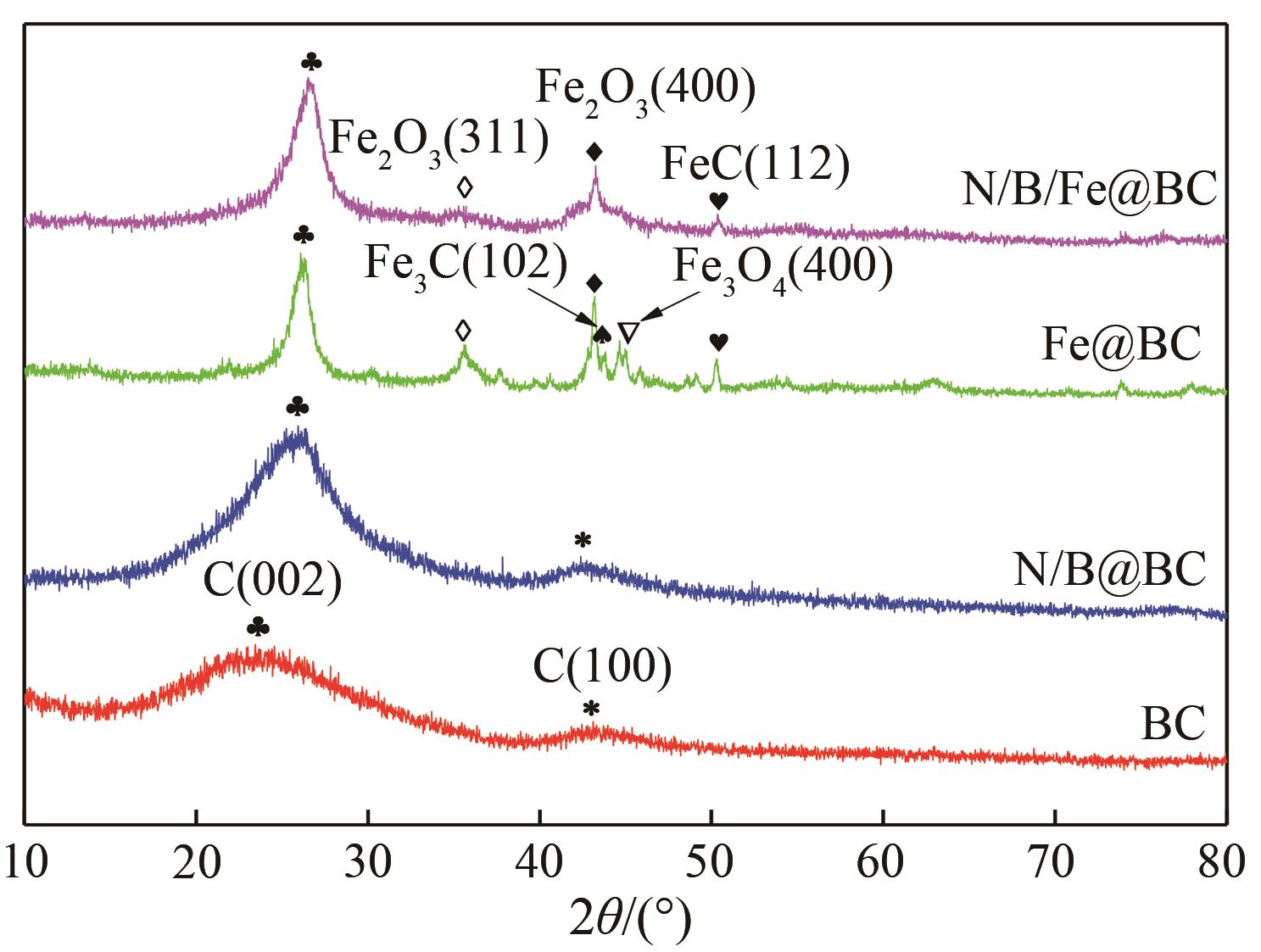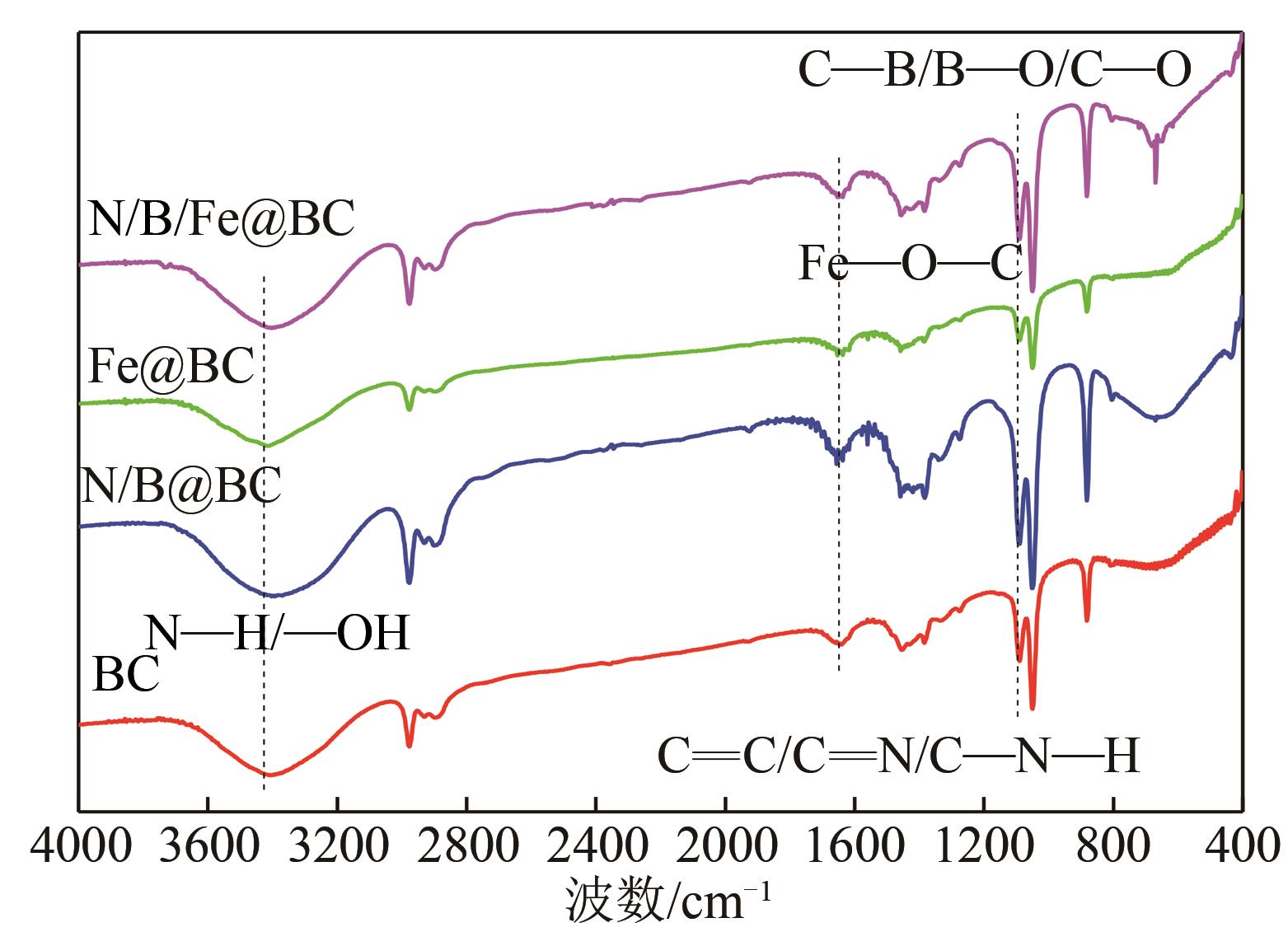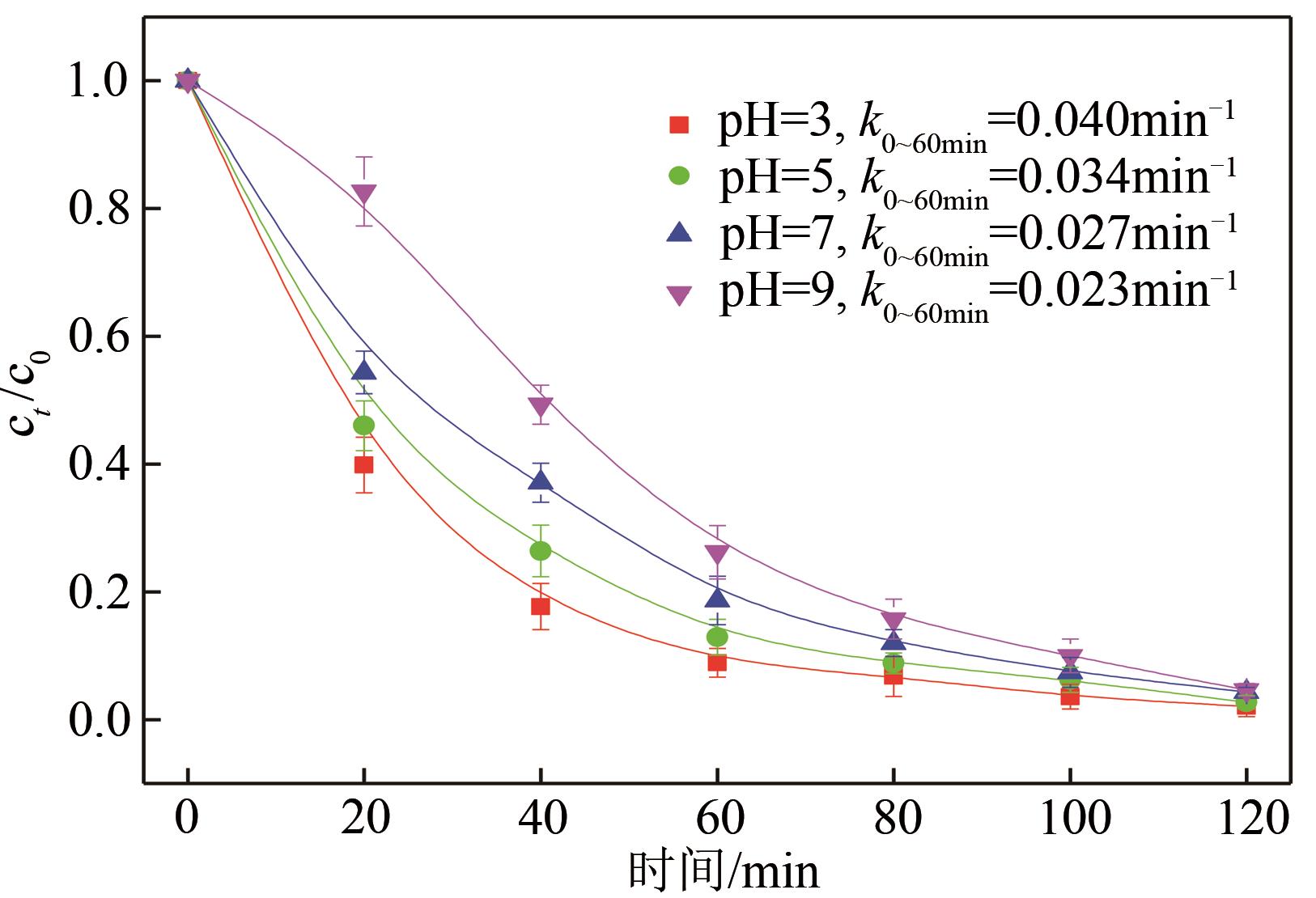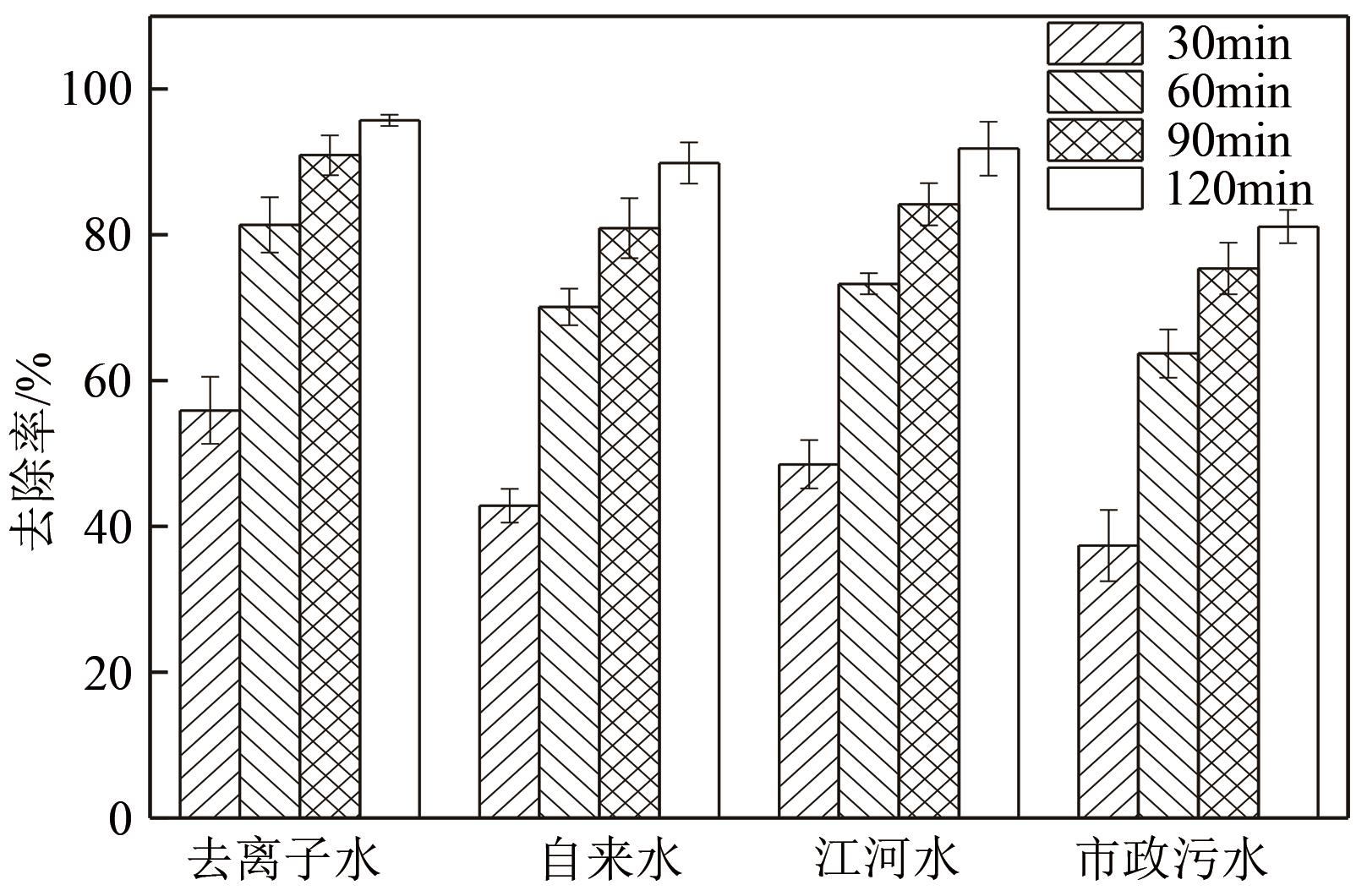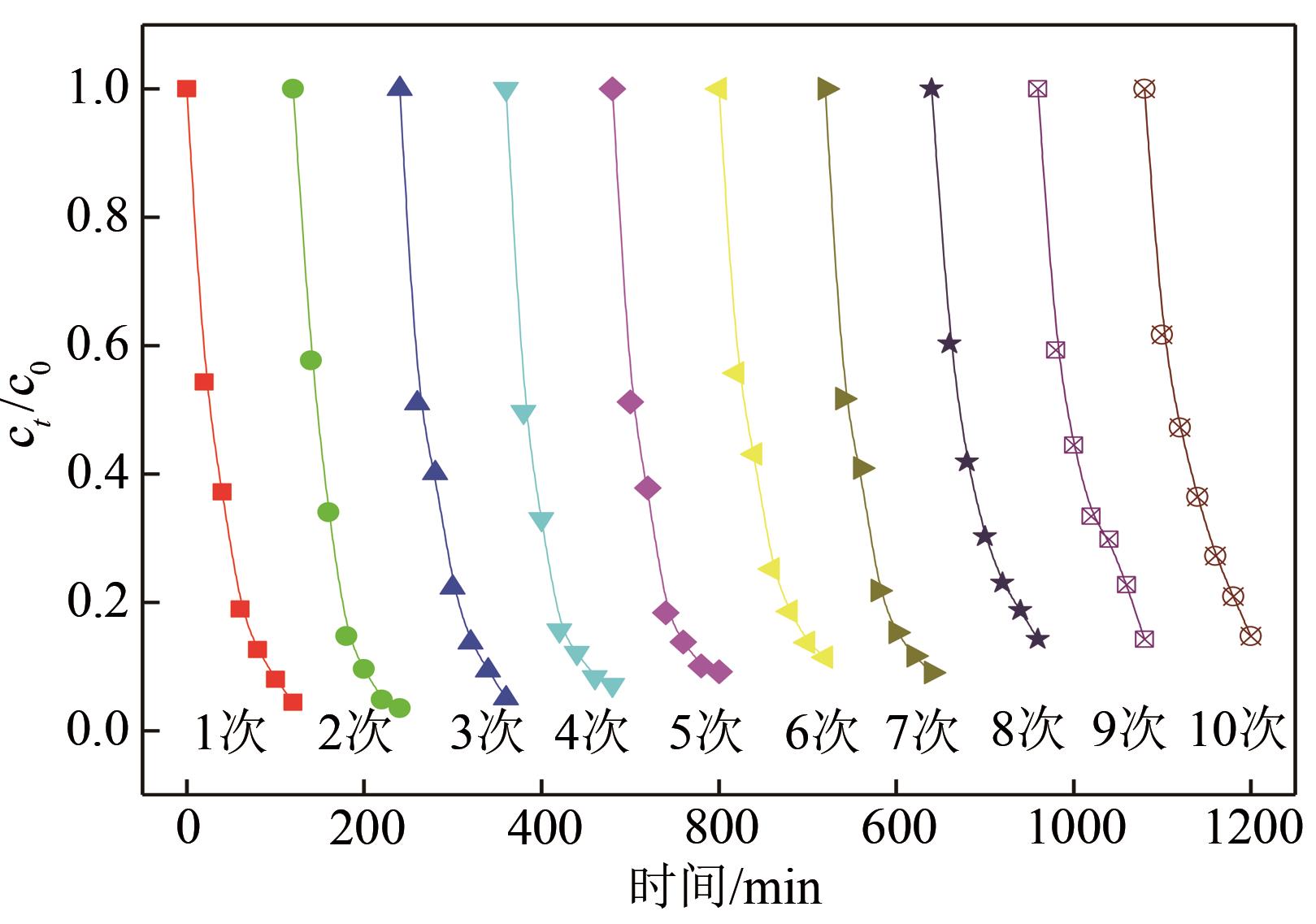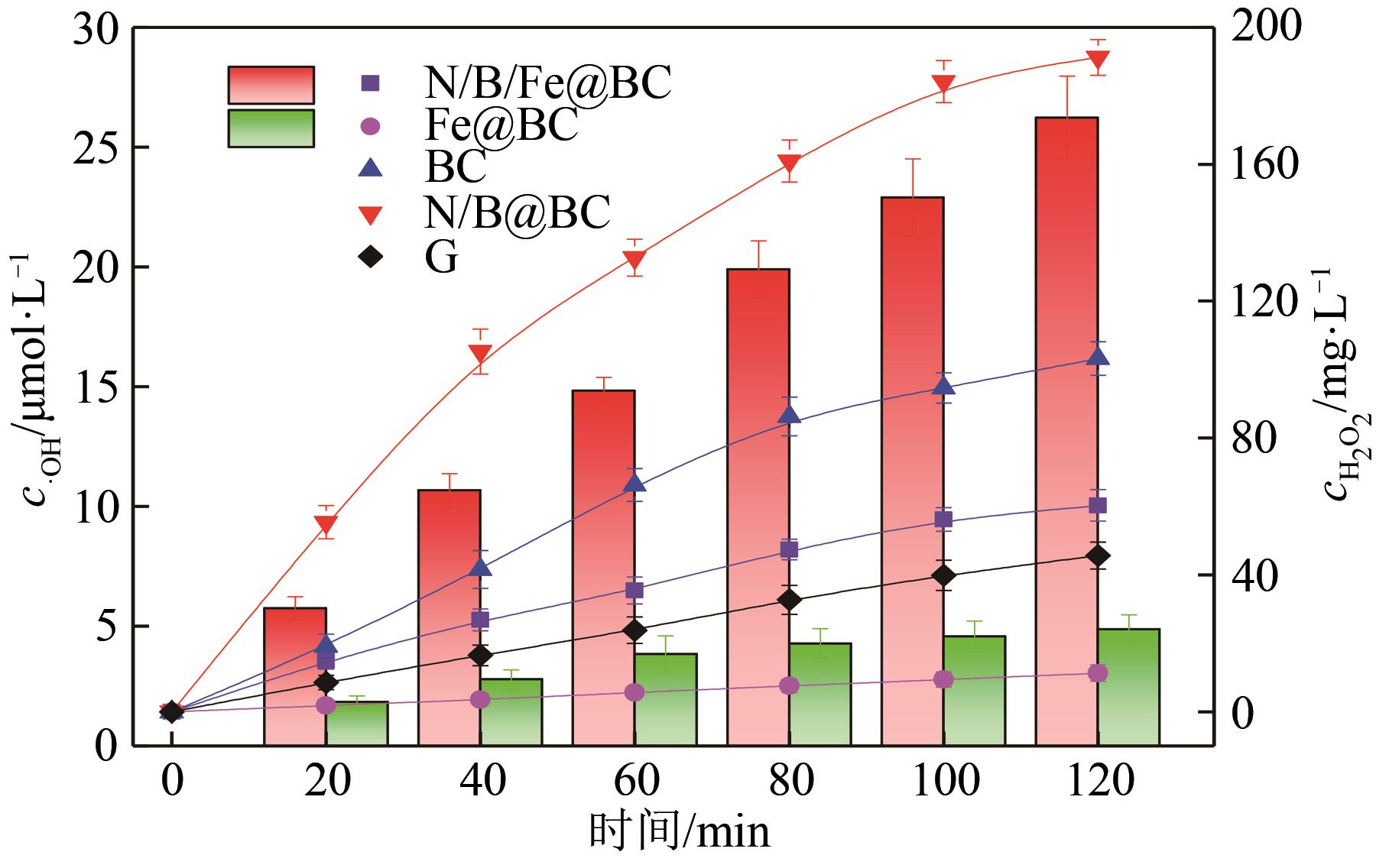化工进展 ›› 2021, Vol. 40 ›› Issue (7): 4064-4073.DOI: 10.16085/j.issn.1000-6613.2020-1646
N/B/Fe共掺杂生物质炭阴极制备及电芬顿降解对硝基酚
汤茜1,2( ), 范艺馨2, 苏欣2, 黄成思1,2, 孙玉伟1,2, 高永慧1, 王栋3
), 范艺馨2, 苏欣2, 黄成思1,2, 孙玉伟1,2, 高永慧1, 王栋3
- 1.吉林省高校环境材料与污染控制重点实验室,吉林 四平 136000
2.吉林师范大学环境科学与工程学院,吉林 四平 136000
3.大连理工大学环境学院,辽宁 大连 116024
-
收稿日期:2020-08-17修回日期:2020-09-10出版日期:2021-07-06发布日期:2021-07-19 -
通讯作者:汤茜 -
作者简介:汤茜(1980—),女,副教授,硕士生导师,研究方向为有机废水高级氧化处理。E-mail:tangqian327@jlnu.edu.cn 。 -
基金资助:国家自然科学基金青年科学基金(51708250);国家级大学生创新创业训练计划支持项目(202010203001)
Preparation of N/B/Fe co-doped biochar cathode for degradation of p-nitrophenol
TANG Qian1,2( ), FAN Yixin2, SU Xin2, HUANG Chengsi1,2, SUN Yuwei1,2, GAO Yonghui1, WANG Dong3
), FAN Yixin2, SU Xin2, HUANG Chengsi1,2, SUN Yuwei1,2, GAO Yonghui1, WANG Dong3
- 1.Key Laboratory of Environmental Materials and Pollution Control, the Education Department of Jilin Province, Jilin Normal University, Siping 136000, Jilin, China
2.College of Environmental Science and Engineering, Jilin Normal University, Siping 136000, Jilin, China
3.School of Environmental Science and Technology, Dalian University of Technology, Dalian 116024, Liaoning, China
-
Received:2020-08-17Revised:2020-09-10Online:2021-07-06Published:2021-07-19 -
Contact:TANG Qian
摘要:
以玉米芯为主要原料,采用热沉积、高温焙烧法,制备N/B/Fe共掺杂生物质炭(N/B/Fe@BC),通过X射线衍射(XRD)、扫描电子显微镜(SEM)、高分辨透射电子显微镜(HRTEM)和X射线光电子能谱仪(XPS)等手段对样品的晶格结构、形貌特征和组成等进行表征,并以对硝基酚为对象,探究N/B/Fe@BC电极的电芬顿催化性能。结果表明,N/B/Fe@BC为纳米薄片交错堆积的三维多孔结构,表面缺陷较未掺杂生物质炭显著增加,催化氧还原以两电子产H2O2为主。在电流强度50mA、初始pH为3的电芬顿体系中,120min时对硝基酚的去除率为97.93%±1.62%,60min内反应速率常数k为0.040min-1,是未掺杂生物质炭电极的2.7倍。N/B/Fe@BC电极的pH适用范围较宽,受水质的影响较小,循环使用10次后120min对硝基酚的去除率仍可达到85%以上。
中图分类号:
引用本文
汤茜, 范艺馨, 苏欣, 黄成思, 孙玉伟, 高永慧, 王栋. N/B/Fe共掺杂生物质炭阴极制备及电芬顿降解对硝基酚[J]. 化工进展, 2021, 40(7): 4064-4073.
TANG Qian, FAN Yixin, SU Xin, HUANG Chengsi, SUN Yuwei, GAO Yonghui, WANG Dong. Preparation of N/B/Fe co-doped biochar cathode for degradation of p-nitrophenol[J]. Chemical Industry and Engineering Progress, 2021, 40(7): 4064-4073.
| 样品 | 电子转移数n | ||||
|---|---|---|---|---|---|
| -0.60V | -0.70V | -0.80V | -0.90V | -1.00V | |
| N/B/Fe@BC | 1.88 | 1.87 | 1.87 | 1.96 | 2.23 |
| Fe@BC | 2.26 | 2.35 | 2.53 | 2.85 | 3.72 |
| N/B@BC | 2.23 | 2.12 | 2.10 | 2.26 | 2.95 |
| BC | 2.10 | 2.13 | 2.22 | 2.49 | 3.38 |
表1 样品的电催化氧还原电子转移数
| 样品 | 电子转移数n | ||||
|---|---|---|---|---|---|
| -0.60V | -0.70V | -0.80V | -0.90V | -1.00V | |
| N/B/Fe@BC | 1.88 | 1.87 | 1.87 | 1.96 | 2.23 |
| Fe@BC | 2.26 | 2.35 | 2.53 | 2.85 | 3.72 |
| N/B@BC | 2.23 | 2.12 | 2.10 | 2.26 | 2.95 |
| BC | 2.10 | 2.13 | 2.22 | 2.49 | 3.38 |
| 1 | XIONG Z K, ZHANG H, ZHANG W C, et al. Removal of nitrophenols and their derivatives by chemical redox: a review[J]. Chemical Engineering Journal, 2019, 359: 13-31. |
| 2 | XU W T, CHEN J N, QIU Y, et al. Highly efficient microwave catalytic oxidation degradation of 4-nitrophenol over magnetically separable NiCo2O4-Bi2O2CO3 composite without adding oxidant[J]. Separation and Purification Technology, 2019, 213: 426-436. |
| 3 | SANTOS A DOS, VIANTE M F, POCHAPSKI D J, et al. Enhanced removal of p-nitrophenol from aqueous media by montmorillonite clay modified with a cationic surfactant[J]. Journal of Hazardous Materials, 2018, 355: 136-144. |
| 4 | 孟启, 舒斌斌, 周峰, 等. 胺化聚苯乙烯树脂的制备及吸附对硝基酚[J]. 化工进展, 2015, 34(6):1714-1719. |
| MENG Q, SHU B B, ZHOU F, et al. Preparation of aminated polystyrene resins and its adsorption of p-nitrophenol[J]. Chemical Industry and Engineering Progress, 2015, 34(6):1714-1719. | |
| 5 | MEI X, LIU J, GUO Z W, et al. Simultaneous p-nitrophenol and nitrogen removal in PNP wastewater treatment: comparison of two integrated membrane-aerated bioreactor systems[J]. Journal of Hazardous Materials, 2019, 363: 99-108. |
| 6 | RODRIGUES C S D, BORGES R A C, LIMA V N, et al. p-Nitrophenol degradation by Fenton's oxidation in a bubble column reactor[J]. Journal of Environmental Management, 2018, 206: 774-785. |
| 7 | LI H Y, XING X, WANG K, et al. Improved BDD anode system in electrochemical degradation of p-nitrophenol by corroding electrode of iron[J]. Electrochimica Acta, 2018, 291: 335-342. |
| 8 | NIE Y C, YU F, WANG L C, et al. Photocatalytic degradation of organic pollutants coupled with simultaneous photocatalytic H-2 evolution over graphene quantum dots/Mn-N-TiO2/g-C3N4 composite catalysts: performance and mechanism[J]. Applied Catalysis B: Environmental, 2018, 227: 312-321. |
| 9 | NIDHEESH P V, GANDHIMATHI R. Trends in electro-Fenton process for water and wastewater treatment: an overview[J]. Desalination, 2012, 299: 1-15. |
| 10 | CHEN S, TANG L, FENG H P, et al. Carbon felt cathodes for electro-Fenton process to remove tetracycline via synergistic adsorption and degradation[J]. Science of the Total Environment, 2019, 670: 921-931. |
| 11 | BRILLAS E, SIRES I, OTURAN M A. Electro-Fenton process and related electrochemical technologies based on Fenton's reaction chemistry[J]. Chemical Reviews, 2009, 109(12): 6570-6631. |
| 12 | ZHOU W, RAJIC L, CHEN L, et al. Activated carbon as effective cathode material in iron-free electro-Fenton process: integrated H2O2 electrogeneration, activation, and pollutants adsorption[J]. Electrochimica Acta, 2019, 296: 317-326. |
| 13 | COLADES J I, DE LUNA M D G, SECONDES M F N, et al. Electrochemical in situ hydrogen peroxide generation in a packed-bed reactor for Fenton oxidation of p-nitrophenol in aqueous solution[J]. Process Safety and Environmental Protection, 2019, 123: 161-168. |
| 14 | JIANG W L, XIA X, HAN J L, et al. Graphene modified electro-Fenton catalytic membrane for in situ degradation of antibiotic florfenicol[J]. Environmental Science & Technology, 2018, 52(17): 9972-9982. |
| 15 | DUAN X G, INDRAWIRAWAN S, SUN H Q, et al. Effects of nitrogen-, boron-, and phosphorus-doping or codoping on metal-free graphene catalysis[J]. Catalysis Today, 2015, 249: 184-191. |
| 16 | ZHAO K, QUAN X, CHEN S, et al. Enhanced electro-Fenton performance by fluorine-doped porous carbon for removal of organic pollutants in wastewater[J]. Chemical Engineering Journal, 2018, 354: 606-615. |
| 17 | FERNANDEZ-SAEZ N, VILLELA-MARTINEZ D E, CARRASCO-MARIN F, et al. Heteroatom-doped graphene aerogels and carbon-magnetite catalysts for the heterogeneous electro-Fenton degradation of acetaminophen in aqueous solution[J]. Journal of Catalysis, 2019, 378: 68-79. |
| 18 | CAO P K, ZHAO K, QUAN X, et al. Efficient and stable heterogeneous electro-Fenton system using iron oxides embedded in Cu, N co-doped hollow porous carbon as functional electrocatalyst[J]. Separation and Purification Technology, 2020, 238: 116424. |
| 19 | PREMARATHNA K S D, RAJAPAKSHA A U, SARKAR B, et al. Biochar-based engineered composites for sorptive decontamination of water: a review[J]. Chemical Engineering Journal, 2019, 372: 536-550. |
| 20 | ZHU S S, HUANG X C, MA F, et al. Catalytic removal of aqueous contaminants on N-doped graphitic biochars: inherent roles of adsorption and nonradical mechanisms[J]. Environmental Science & Technology, 2018, 52(15): 8649-8658. |
| 21 | SIZMUR T, FRESNO T, AKGUL G, et al. Biochar modification to enhance sorption of inorganics from water [J]. Bioresource Technology, 2017, 246: 34-47. |
| 22 | 余剑刚, 张兴文, 王栋, 等. 水热改性热解生物炭的制备、表征及吸附特性[J]. 工业水处理, 2018, 38(9): 53-57. |
| YU J G, ZHANG X W, WANG D, et al. Preparation,characterization and adsorption performance of hydrothermal modified pyrolysis biochar[J]. Industrial Water Treatment, 2018, 38(9): 53-57. | |
| 23 | DENG F X, OLVERA-VARGAS H, GARCIA-RODRIGUEZ O, et al. Waste-wood-derived biochar cathode and its application in electro-Fenton for sulfathiazole treatment at alkaline pH with pyrophosphate electrolyte[J]. Journal of Hazardous Materials, 2019, 377: 249-258. |
| 24 | LIANG J X, TANG D Y, HUANG L, et al. High oxygen reduction reaction performance nitrogen-doped biochar cathode: a strategy for comprehensive utilizing nitrogen and carbon in water hyacinth[J]. Bioresource Technology, 2018, 267: 524-531. |
| 25 | ZHAO H Y, CHEN Y, PENG Q S, et al. Catalytic activity of MOF(2Fe/Co)/carbon aerogel for improving H2O2 and ·OH generation in solar photo-electro-Fenton process[J]. Applied Catalysis B: Environmental, 2017, 203: 127-137. |
| 26 | YUAN H R, CHEN H B, LI D N, et al. Catalytic synthesis and simultaneous co-doping of hierarchically porous carbon with in situ coated graphene from biomass tar as efficient catalyst for ORR[J]. Electrochemistry Communications, 2019, 100: 52-59. |
| 27 | SELLERS R M. Spectrophotometric determination of hydrogen peroxide using potassium titanium(Ⅳ) oxalate[J]. The Analyst, 1980, 105(1255): 950-954. |
| 28 | BABA Y, YATAGAI T, HARADA T, et al. Hydroxyl radical generation in the photo-Fenton process: effects of carboxylic acids on iron redox cycling[J]. Chemical Engineering Journal, 2015, 277: 229-241. |
| 29 | ZHAO H Y, QIAN L, CHEN Y, et al. Selective catalytic two-electron O2 reduction for onsite efficient oxidation reaction in heterogeneous electro-Fenton process[J]. Chemical Engineering Journal, 2018, 332: 486-498. |
| 30 | JIAO Y, WAN C C, BAO W H, et al. Facile hydrothermal synthesis of Fe3O4@cellulose aerogel nanocomposite and its application in Fenton-like degradation of Rhodamine B[J]. Carbohydrate Polymers, 2018, 189: 371-378. |
| 31 | 郭斌斌, 欧阳静, 杨华明. 埃洛石管内负载纳米四氧化三铁复合材料对亚甲基蓝的吸附性能[J]. 硅酸盐学报, 2016, 44(11): 1655-1661. |
| GUO B B, OUYANG J, YANG H M. Adsorption performance to methylene blue by nano-Fe3O4 assembled in lumen of halloysite nanotubes[J]. Journal of the Chinese Ceramic Society, 2016, 44(11): 1655-1661. | |
| 32 | 俞志敏, 卫新来, 娄梅生, 等. 氯化锌活化生物质炭制备活性炭及其表征[J]. 化工进展, 2014, 33(12): 3318-3323. |
| YU Z M, WEI X L, LOU M S, et al. Preparation and characterization of activated carbon from bio-char by chemical activation with ZnCl2[J]. Chemical Industry and Engineering Progress, 2014, 33(12): 3318-3323. | |
| 33 | LEE D, LEE B, PARK K H, et al. Scalable exfoliation process for highly soluble boron nitride nanoplatelets by hydroxide-assisted ball milling[J]. Nano Letters, 2015, 15(2): 1238-1244. |
| 34 | THIRUMAL V, PANDURANGAN A, JAYAVEL R, et al. Synthesis and characterization of boron doped graphene nanosheets for supercapacitor applications[J]. Synthetic Metals, 2016, 220: 524-532. |
| 35 | 张凯, 韦秀丽, 王冰, 等. Fe3O4改性水热炭活化过硫酸钠降解罗丹明B[J]. 化工进展, 2020, 39(7): 2867-2875. |
| ZHANG K, WEI X L, WANG B, et al. Degradation of Rhodamine B by sodium persulfate activated with Fe3O4 modified hydrochar[J]. Chemical Industry and Engineering Progress, 2020, 39(7): 2867-2875. | |
| 36 | ZHOU H, WU S K, ZHOU Y Y, et al. Insights into the oxidation of organic contaminants by iron nanoparticles encapsulated within boron and nitrogen co-doped carbon nanoshell: catalyzed Fenton-like reaction at natural pH[J]. Environment International, 2019, 128: 77-88. |
| 37 | LIANG H W, WEI W, WU Z S, et al. Mesoporous metal-nitrogen-doped carbon electrocatalysts for highly efficient oxygen reduction reaction[J]. Journal of the American Chemical Society, 2013, 135(43): 16002-16005. |
| 38 | ZHENG Y, JIAO Y, GE L, et al. Two-step boron and nitrogen doping in graphene for enhanced synergistic catalysis[J]. Angewandte Chemie International Edition, 2013, 52(11): 3110-3116. |
| 39 | CHEN S C, CHEN Z H, SIAHROSTAMI S, et al. Designing boron nitride islands in carbon materials for efficient electrochemical synthesis of hydrogen peroxide[J]. Journal of the American Chemical Society, 2018, 140(25): 7851-7859. |
| 40 | LAN H C, LI J F, SUN M, et al. Efficient conversion of dimethylarsinate into arsenic and its simultaneous adsorption removal over FeCx/N-doped carbon fiber composite in an electro-Fenton process [J]. Water Research, 2016, 100: 57-64. |
| 41 | SUN Y Y, SINEV I, JU W, et al. Efficient electrochemical hydrogen peroxide production from molecular oxygen on nitrogen-doped mesoporous carbon catalysts[J]. ACS Catalysis, 2018, 8(4): 2844-2856. |
| 42 | HUANG T Z, MAO S, QIU M, et al. Nitrogen-boron dipolar-doped nanocarbon as a high-efficiency electrocatalyst for oxygen reduction reaction[J]. Electrochimica Acta, 2016, 222: 481-487. |
| 43 | SU P, ZHOU M H, REN G B, et al. A carbon nanotube-confined iron modified cathode with prominent stability and activity for heterogeneous electro-Fenton reactions[J]. Journal of Materials Chemistry A, 2019, 7(42): 24408-24419. |
| 44 | DONG P, LIU W J, WANG S J, et al. In suit synthesis of Fe3O4 on carbon fiber paper@polyaniline substrate as novel self-supported electrode for heterogeneous electro-Fenton oxidation[J]. Electrochimica Acta, 2019, 308: 54-63. |
| 45 | YANG W L, ZHOU M H, LIANG L. Highly efficient in-situ metal-free electrochemical advanced oxidation process using graphite felt modified with N-doped graphene[J]. Chemical Engineering Journal, 2018, 338: 700-708. |
| [1] | 徐虎, 郭泓凯, 柴昌盛, 郝相忠, 杨子元, 徐卫军. 碳纤维类材料用于电芬顿体系电极的研究现状[J]. 化工进展, 2022, 41(7): 3707-3718. |
| [2] | 宋少花, 徐金兰, 宋晓乔, 于媛. 磁性生物质炭的制备及在污染水体中的应用[J]. 化工进展, 2022, 41(12): 6586-6605. |
| [3] | 李庆林, 宋涛, 杨勇. 生物质炭基材料在有机催化转化中的应用[J]. 化工进展, 2021, 40(4): 1966-1982. |
| [4] | 曲可琪, 尤月, 孙哲, 黄占华. 氮硼掺杂菌糠炭:蜂窝结构用于电极材料[J]. 化工进展, 2021, 40(3): 1527-1536. |
| [5] | 田玉菲, 杨莉, 周鸣人, 张存胜. 玉米芯与鸡粪混合发酵提高甲烷发酵性能[J]. 化工进展, 2019, 38(06): 2898-2904. |
| [6] | 朱赫男, 王志朴, 邢文龙, 舒新前. 污泥与生物质共热解制备生物质炭工艺优化及吸附性能[J]. 化工进展, 2018, 37(S1): 199-204. |
| [7] | 闫思佳, 胡建杭, 刘泽伟, 袁晓涛, 李慧. 温度和低氧条件对成型生物质炭孔结构影响的实验研究[J]. 化工进展, 2018, 37(08): 3100-3106. |
| [8] | 李光源, 吴轩韬, 王杰. 两种反应器中生物质炭水蒸气催化气化的动力学[J]. 化工进展, 2018, 37(08): 2984-2990. |
| [9] | 屈笑笑, 邢宝林, 康伟伟, 张传涛, 黄光许, 赵会会, 田野, 郭梦瑶, 张传祥. 玉米芯电容炭的制备及其电化学性能[J]. 化工进展, 2018, 37(06): 2340-2346. |
| [10] | 贾爽, 应浩, 徐卫, 孙云娟, 尹航, 宁思云, 孙宁. 生物质炭水蒸气气化制取富氢合成气[J]. 化工进展, 2018, 37(04): 1402-1407. |
| [11] | 吴月, 孙宇维, 王岽, 张健, 何沛然, 李玉平, 张忠国, 曹宏斌. 曝气及外加H2O2强化电芬顿法处理石化反渗透浓水[J]. 化工进展, 2017, 36(09): 3523-3530. |
| [12] | 郭磊, 尤伟娜, 赵欣, 胡仰栋, 伍联营. 玉米芯脱盐及脱蛋白的预处理工艺[J]. 化工进展, 2017, 36(05): 1927-1932. |
| [13] | 孟启, 舒斌斌, 周峰, 夏丰敏, 孙小强. 胺化聚苯乙烯树脂的制备及吸附对硝基酚[J]. 化工进展, 2015, 34(06): 1714-1719. |
| [14] | 俞志敏1,2,卫新来1,2,娄梅生2,3,熊鸿斌3,吴宗杰1,金杰1,2,吴克1. 氯化锌活化生物质炭制备活性炭及其表征[J]. 化工进展, 2014, 33(12): 3318-3323. |
| [15] | 岳丽清1,2,肖清贵2,王天贵1,徐红彬2,曹宏斌2,张 懿2. 三苯基磷在玉米芯制备糠醛中的应用[J]. 化工进展, 2012, 31(05): 1103-1108. |
| 阅读次数 | ||||||
|
全文 |
|
|||||
|
摘要 |
|
|||||

